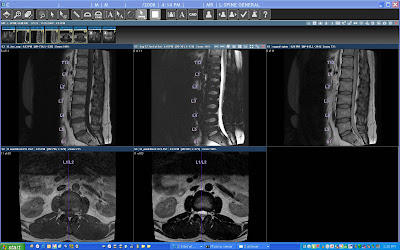My friend Mike Cannavo, the One and Only PACSMan, called me from the RSNA exhibit floor this afternoon, both to chide and congratulate me for avoiding the show this year. Apparently attendance is OK so far, but there seems to be a lot of hesitation over spending any money, given the state of the economy, as well as the uncertainties of medicine's future.
By staying home from Chicago, I unfortunately will miss the world premier of the latest version of Amicas PACS. The program's original code-name was"Phoenix" or more properly, Version 6, or V6 for short. A number of us users were asked about fancier titles, maybe something like Visionary PACS, X-Ray Vision PACS, I-Can-See-You-Without-Clothes PACS, or maybe NOT-Centricity PACS. But by the time the Amicas brass contacted me, they had pretty much decided on the simple, straight-forward title of "Amicas PACS", and I had to agree it was the best choice. That's what we call it around here anyway. (They did bow to some X-Box 360 fan and titled the viewer component "Halo Viewer," but I'll forgive them for that.
I played a minor role in the development of this product, and I have been running it from a test-server connected to our system. Thus, I can reveal to the rest of the radiology world, those folks that didn't go to RSNA this year anyway, just what V6 is all about.
Amicas has come up with some new approaches to PACS, while keeping much of what has made this my favorite system. I won't go through excruciating detail about every aspect of the system, but these screen-shots will give you an idea of how Amicas PACS functions.
Amicas' Real-Time Worklist (RTWL) is similar to it's predecessors, although it has been updated a bit. It still offers at-a-glance assessment of your worklist status, something the competition hasn't quite mastered. The new display has a twist, in that it shares space with a display of the current exam and its series as well as those of relevant priors, and it's a nice addition:
Once the study is selected, the primary study and relevant priors are displayed based on your hanging protocols, as well as anatomic relational rules.
The older Amicas programs used a limited port of Voxar 3D for advanced visualization, one of the first PACS to have such functionality directly embedded. Amicas PACS (V6) goes way beyond this, adding some very powerful 3D and MPR displays that are reminiscent of Siemens InSpace:
Our old friend, spine-labelling, is here with little change, but fortunately none was needed for this module that set the standard for this sort of thing. Here is Amicas programming at its best: the module is very simple to use, and IT WORKS! I can label a spine in all views within 5 seconds.
There's a lot of power here in V6, I mean Amicas PACS, folks. The functionality should go a long way toward smoothing out my worklist, and thus my work day. Obviously, some of the simplicity of the old program had to be sacrificed to gain that strength. Still, there is very little fluff here, nothing that doesn't belong, and as near as I can tell, there isn't much that was thrown in because one (and only one) site demanded it. I have long complained about GUI's that have too many buttons and too many functions, and it was my goal as part of the advisory team to keep that from happening to the new Amicas PACS. I think you'll find a very nice balance of usability and power when you try out Amicas PACS. It's definitely worth your while, and it is certainly a better investment of your shrinking health-care dollar than my stock portfolio. . .







2 comments :
Well, finally...2 years after showing it (RSNA 2005) they are releasing it? No. Still showing it.
Come on Dalai...it's binary...released or not? You don't have the released code. Still "R"eal "S"oftware "N"ot "A"vailable.
You are a good disciple.
Just got back from RSNA.
Amicas V6.0 interface looks kind of "busy" to me.
I rarely hear any comments about mammo reads from Amicas. Looks like V6 will be at least OK for mammo.
My practice does a lot of mammo and having to use Hologic for viewing, Amicas for opening/signing off/launching VR and locking down the study, and VR system stinks. throw in some analog comparisons for kicks. You need to be an octopus to do it all.
Concerning PET...the product looked unrefined. Some problems linking CT to PET images. didn't see how comparisons were handled (most all PETs have comps. Fusion requires some 3rd party app. I didn't do a full eval. but saw enough to realize that I'd prefer to use a dedicated GE PET workstation for it.
As far as 3D,etc...I still think Terarecon kicks all the included crap in Amicas. Enough so that we bought the TR unit and integrated it. Everybody in my group hated the watered down Voxar crud. Glancing over the V6 advanced viewing package...I still like TR.
-Houston
Jackson, MS
Post a Comment